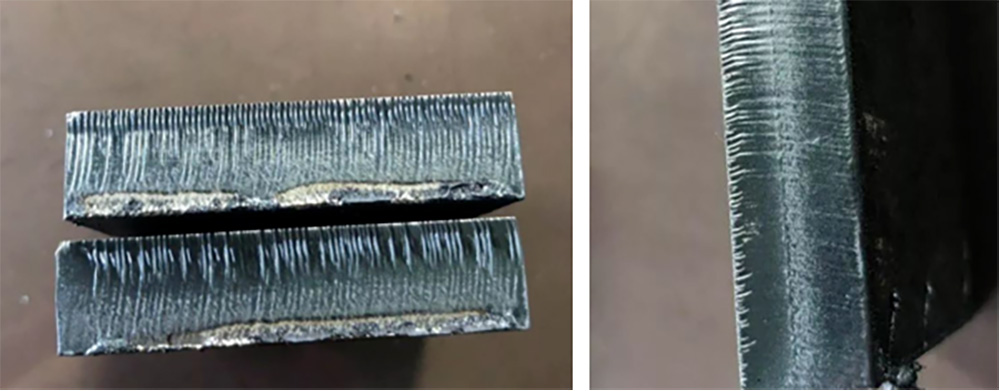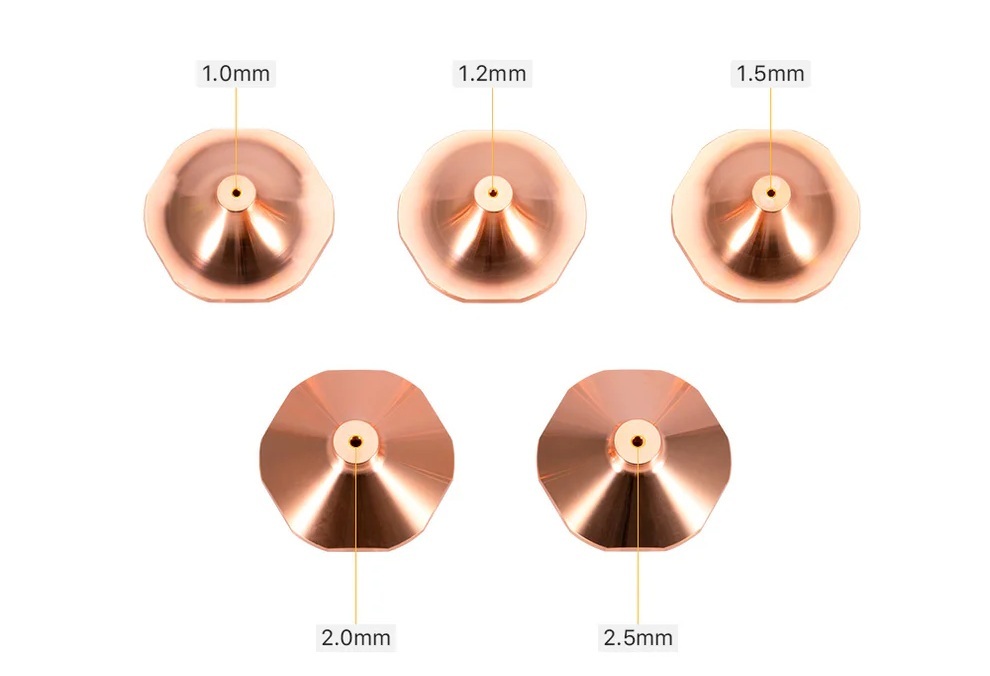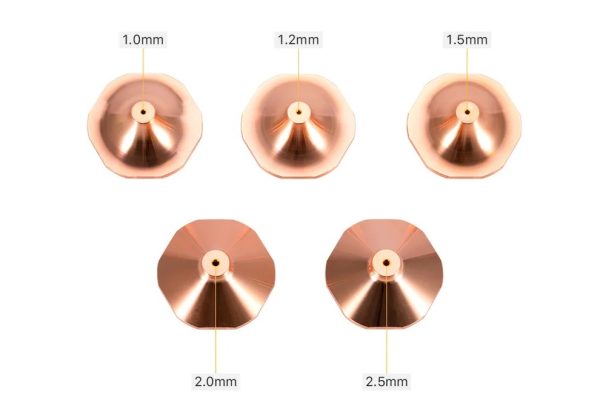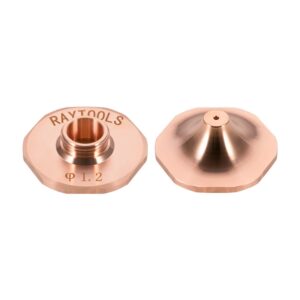In the world of precision metal processing, laser cutting has become a core technology for industries ranging from automotive and aerospace to electronics and construction. While much attention is often given to the laser source, optics, or cutting software, one small component plays a disproportionately large role in determining the final cutting quality: the cutting head nozzle.
The nozzle may look simple, but it directly influences assist gas flow, beam focus stability, and overall cut performance. Choosing the wrong nozzle, or failing to maintain it properly, can result in poor edge quality, dross accumulation, higher gas consumption, and reduced productivity. Conversely, the right nozzle selection ensures stable cutting, smooth edges, and cost efficiency.
This article explores the critical factors to consider when choosing nozzles for laser cutting machines, drawing attention to size, shape, material, gas type, and stand-off distance.
Why the Laser Cutting Head Nozzle Matters
The nozzle’s main functions are to direct assist gas onto the molten metal, maintain beam coaxiality, and stabilize cutting results. The gas jet must be symmetrical and consistent; otherwise, the molten material cannot be blown out effectively. Even slight deviations in nozzle geometry can cause uneven edges, slag adhesion, or incomplete penetration.
- When Nozzle is Too Big

- When Nozzle is Too Small

If the nozzle is improperly designed and maintained, and the processing accuracy is insufficient, the gas flow rate will be reduced and the airflow direction will become unstable, which will affect the melting of the material during the cutting process and produce melt stains. Cutting thicker plates may even make it impossible to cut.
A nozzle that matches both the material type and cutting parameters is essential for maximizing the performance of your laser cutting system.
Key Factors in Nozzle Selection
Below is a table outlining the main considerations when selecting a laser cutting nozzle:
Table 1: Key Dimensions for Selecting Laser Cutting Nozzles
| Selection Dimension | Recommended Choice | Description & Application Scenario |
|---|---|---|
| Type | Single-layer nozzle | Suitable for stainless steel and aluminum nitrogen cutting. Provides high gas flow efficiency. |
| Double-layer nozzle | Suitable for carbon steel oxygen cutting. Helps stabilize the molten pool. | |
| Material | Copper (preferred) over brass | Copper has better heat and electrical conductivity, resulting in longer service life, lower head temperature, and reduced spatter adhesion. |
| Aperture Diameter | 1.0 mm nozzle | Recommended for thin plates under 3 mm; ensures fine and precise gas flow. |
| 1.5 mm nozzle | Suitable for medium-thickness plates of 3–10 mm; balances flow and stability. | |
| 2.0 mm or larger nozzle | Recommended for plates over 10 mm to ensure sufficient gas flow and penetration. | |
| Processing Accuracy | Nozzle concentricity <0.03 mm | Standard requirement to ensure alignment between laser beam and gas flow. |
| For apertures <1 mm, concentricity ≤0.02 mm | Stricter tolerance needed for small orifices to avoid beam hitting the nozzle wall and to ensure smooth cutting. |
Matching Nozzles to Different Applications
Table 2: Common Nozzle Types and Their Applications
| Name | Symbol | External Shape | Shape Characteristics | Application |
|---|---|---|---|---|
| Single-layer nozzle | S (Single) | Round inner wall | Allows strong gas flow; high-pressure assist gas forms a concentrated stream. | Used for stainless steel, aluminum, and other oxidation-free cutting. |
| Double-layer nozzle | D (Double) | Composite double-layer | Inner core added on top of single-layer; enhances stability. | Mainly for carbon steel cutting (below 2.0 mm aperture). |
| High-speed double-layer nozzle | E | Pointed outer shape | Inner core edges are triangular, improving gas concentration. | For carbon steel high-power, high-speed cutting within 20 mm. |
| High-speed single-layer nozzle | SP | Pointed with stepped circular inner wall | Provides smooth gas acceleration for deep penetration. | For carbon steel bright-surface cutting above 20 mm, or high load cutting. |
| High-speed single-layer nozzle (advanced) | ST | Pointed, round inner wall | Wider nozzle outlet than SP, delivering greater gas volume. | For carbon steel high-speed cutting above 20 mm; more efficient with consistent results. |
| Boost nozzle | B (Boost) | Based on single-layer, with stepped nozzle mouth | Produces layered airflow to enhance gas dynamics. | Suitable for stainless steel or aluminum cutting with high-pressure nitrogen or low-pressure oxygen |

Common Issues from Poor Nozzle Choice
Even high-power fiber laser cutting systems cannot compensate for nozzle problems. Some typical issues include:
- Dross buildup: Caused by insufficient gas flow or poor nozzle roundness.
- Rough edges and taper: Occur when nozzle alignment is off-center or aperture size mismatched.
- Spatter sticking to nozzle: Often due to improper stand-off distance or nozzle wear.
- High gas consumption: Using a nozzle with an oversized aperture wastes gas and raises costs.
- Frequent replacement needs: Low-quality nozzle materials deform quickly under heat and pressure.
Best Practices for Nozzle Selection and Maintenance
- Inspect regularly: Replace nozzles showing wear, deformation, or discoloration.
- Maintain correct stand-off: Adjust with automatic height control systems for stable focus.
- Match aperture to thickness: Smaller diameters for thin sheets, larger for thick plates.
- Ensure gas purity: Especially for nitrogen, use 99.99% purity to avoid contamination.
- Keep spares: Stock multiple sizes and types to adapt to varying production needs.
- Use reputable suppliers: High-precision, well-machined nozzles guarantee stable results.
Conclusion
The nozzle may be a small component of a laser cutting head, but it plays a decisive role in cut quality, efficiency, and cost control. By carefully considering nozzle size, type, material, assist gas, and stand-off distance, manufacturers can achieve consistently clean edges, higher productivity, and reduced maintenance downtime.
For companies looking to improve their laser cutting performance, investing in the right nozzles and adopting proper maintenance practices is one of the most effective strategies.


